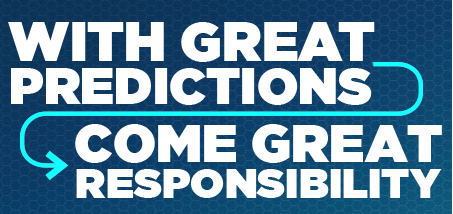7 Marketing Predictions for Midsize Businesses in 2014
Patrick McFadden • September 11, 2013
Are you wondering what 2014 might look like for marketing?
How will marketing impact midsize businesses in 2014?
What if you had a glimpse into the future?
To give you a glimpse of what I think midsize businesses can expect in the next year. I’ve decided to tap my deep knowledge and expertise.
Here are my 7 marketing predictions for midsize businesses in 2014:
- Customers Trust Customers. This is nothing new, but will be more of a focus. Customers referred products and services to each other before the Internet existed. The most recent study on the topic, showed 70% of consumers trusted consumer ratings and reviews. Are you getting customers to share their experience, rate your product or service or even write a review?
- Exceed Customer Expectations. Provide remarkable service in real life (or however you interact with prospects and customers.) Nothing beats remarkable, amazing, wow service for generating positive word of mouth. Midsize companies must commit to massively exceeding customer expectations. After all, the praise you earn online almost always comes from real actions offline.
- Continued Empowerment of the Consumer. Time to give consumers the key to the car. Empowered consumers reward you with loyalty. I’m a huge advocate of any way we can use generosity and information to build businesses, sell products and support our economy. Becoming a trusted informational provider, makes the purchasing process easier and more fun, and is the reason I see the information-empowered consumer as a huge growth trend in 2014.
- Real-Time Problem Solving. Midsize businesses will move to agile marketing and real-time thinking. With communication being impacted by the internet, disgruntled customers expect answers faster through social media channels. This calls for midsize businesses need to master the art of opportunistic marketing and the art of real-time response. For that, midsize businesses need the right infrastructure and agile processes that will allow them to intuitively and immediately pick up on the marketing opportunities. They also need strategic partnerships that can adapt, react and support them in real-time as well.
- Fewer channels. In 2014, I think midsize businesses will have a nuts-and-bolts focus on getting the most out of the channels that fit their business. They will focus on fewer channels , and they’ll want to go deep in them instead of being diluted across all channels . The adage of “deep not wide” will ring true for the midsize companies that stay focused.
- Customer Engagement . In 2014 engagement strategies will be at the top of the list for midsize businesses. Making marketing activities and interactions worth participating in will be the goal. I foresee the use of different communication channels for celebrating customers by giving them a chance in the spotlight, connecting them with customer service sessions, giveaways and contests, and free product demos.
- Customize Service. Last, but certainly not least, I see customize service being something that’s a huge marketing play in 2014. Having customize service not only deepens the relationship with customers but also means that customers are also investing in the relationship. Plus this creates a lock-in effect.
So, that’s my list of 2014 marketing predictions. Do you Agree? Disagree?
What’s your 2014 marketing predication for midsize businesses?

1. The Challenge: VMI was like many service providers — positioning their value around what they thought clients wanted : “Office furniture installation and assembly — let us handle creating your perfect workspace.” But the actual buyers — facility managers, project managers, furniture reps — weren’t looking for “perfect workspaces.” They were trying to avoid installation nightmares . Their real priority? ✅ Great installation days. ✅ No chaos. ✅ No missed deadlines. ✅ No angry phone calls from clients. 2. The Insight: After conducting stakeholder interviews under our marketing strategy consulting engagement , the Indispensable Marketing team uncovered critical feedback: “We need installers who maintain a professional site and follow instructions.” “We lose relationships when installations go badly.” “I need quotes back quickly or I can’t sell the job.” This wasn’t just about services , it was about trust, problem-solving , and professional reliability . So we reframed their differentiators not by what they did, but how they showed up : Same-day project quotes Problem-solving on-site Update protocol with clients Professionalism guarantee Lasting Impression Insurance 3. The Shift: We shifted the positioning from vague benefits to real-world, emotional triggers : Instead of: “Let us create your perfect workspace.” Now: “Get the perfect installation day, every time.” That subtle shift aligns with who’s actually buying (and who feels the pain when things go wrong). The end-user may care about the workspace. But the buyer cares about the install . 4. The Lesson for Others: If you’re selling a service, don’t describe what you do. Describe what the client wants to avoid or achieve — and who the real buyer is. Then, systematize what you’re already doing well and give it a name. Just like our team did with: “Same Day Quotes” “Lasting Impression Insurance” “Reliable Presence Protocol” 5. The Outcome Within weeks of updating their messaging and positioning: The company reported more qualified leads asking the right questions Furniture reps began referring them because they were “easy to work with and made them look good” They were shortlisted for larger, multi-phase projects due to increased confidence in their process But most importantly, they stopped competing on price — because they weren’t selling perfect workspaces anymore. They were selling peace of mind on installation day.




